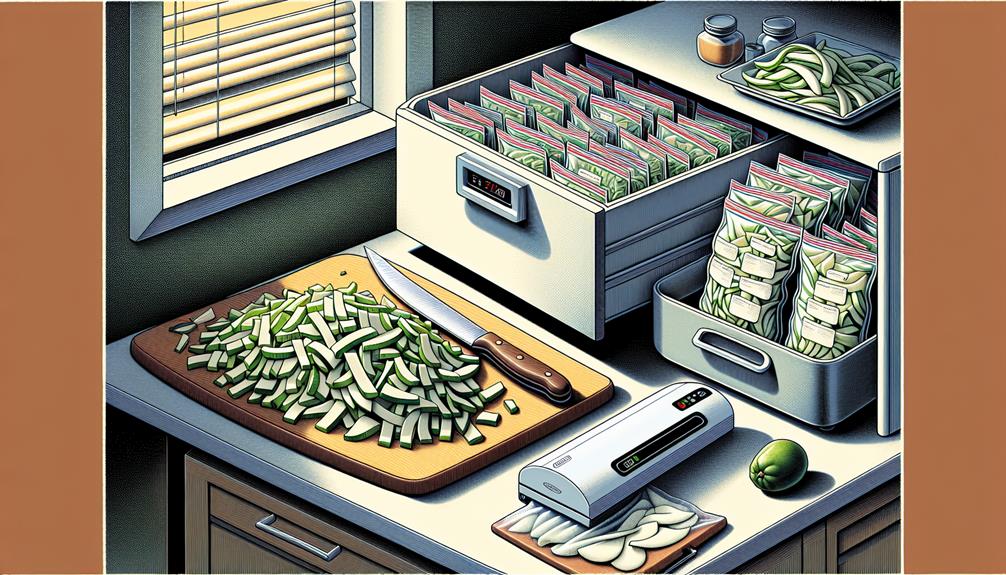Nearly 20% of root vegetables, including jicama, are wasted each year due to improper storage and preservation methods. If you're looking to extend the shelf life of your jicama, freezing is a viable option.
To ensure optimal freshness, you'll need to select firm, unblemished tubers and prepare them correctly before they hit the cold air of your freezer. The process involves blanching, which not only preserves the texture but also the flavor and nutritional value.
As you pack your jicama for freezing, consider the space-saving and protective packaging techniques that can prevent freezer burn and maintain quality.
And when it's time to bring your jicama back to the table, knowing the proper thawing methods is key to enjoying its crisp, refreshing taste.
Stick around to uncover these essential steps that can help you savor your jicama long beyond its typical season.
Key Takeaways
- Look for firm, dry jicama with unblemished, golden-brown skin.
- Blanch the jicama before freezing to preserve its texture and color.
- Use airtight containers or freezer bags to prevent freezer burn.
- Thaw frozen jicama gently in the refrigerator overnight to minimize texture changes.
Selecting Quality Jicama
Choosing the right jicama is crucial; look for firm, dry roots with unblemished, golden-brown skin to ensure the best flavor and texture. You'll want to avoid any that are shriveled or have wet, soft spots, as these are signs the root may be past its prime.
Jicama nutrition is impressive; it's low in calories but high in essential nutrients, making it a healthy addition to your diet. Rich in dietary fiber, jicama promotes good digestive health and can aid in keeping you regular. It's also packed with vitamin C, an antioxidant that supports the immune system and skin health.
The tuber contains important minerals like potassium and iron, which are vital for maintaining body functions, including heart health and oxygen transport. The health benefits of jicama extend to weight management too. Its high water content and fibrous nature help you feel full, reducing overall calorie intake without skimping on nutrients.
Whether you're eating it raw in a salad, stir-fried, or planning to freeze it for later use, selecting a quality jicama is the first step to enjoying all the healthful advantages it offers.
Preparing Jicama for Freezing
Once you've selected a high-quality jicama, you'll need to properly prepare it for freezing to maintain its crisp texture and nutritional value. The preparation process involves a few straightforward steps that you can easily follow.
Before diving into the freezing process, consider these essential steps:
- Wash and Peel: Rinse your jicama thoroughly under cool running water. Then, use a vegetable peeler or a sharp knife to remove the fibrous skin, revealing the starchy white interior.
- Slice and Dice: Employ cutting techniques that suit your future culinary use. For salads, julienne the jicama, or for stews, cube it. Uniform pieces will freeze and thaw more consistently.
- Blanch if Desired: Though not mandatory, blanching can help preserve the texture and color of jicama. Simply boil the pieces for a few minutes, then plunge them into ice water to halt the cooking process.
- Dry Thoroughly: Pat the jicama dry with clean kitchen towels or let it air dry. Excess moisture can lead to ice crystals, which might affect the texture upon thawing.
As for freezing alternatives, flash-freezing individual pieces on a baking sheet before transferring to airtight containers can prevent clumping, making it easier to use only what you need later. Remember, the care you take in preparing jicama will reflect in the quality when it's time to thaw and use it.
Blanching Process Explained
To ensure your jicama retains its crispness and color during freezing, consider blanching it, a quick pre-freeze technique that involves briefly boiling the vegetable pieces. Blanching benefits your jicama by halting enzyme actions which can cause loss of flavor, color, and texture. This simple step is vital for texture preservation and can make a significant difference in the quality of your frozen jicama.
Here's how you blanch jicama:
- Start by heating a large pot of water to a rolling boil. You'll want enough water to cover the jicama pieces completely.
- While waiting for the water to boil, prepare a bowl of ice water.
- Cut your jicama into uniform pieces to ensure even blanching.
- Once the water is boiling, add the jicama and let it boil for about 3-4 minutes.
After blanching, quickly remove the jicama pieces using a slotted spoon and plunge them into the ice water. This stops the cooking process immediately, preserving the desirable crisp texture. Let the jicama cool in the ice bath for the same amount of time it was in the boiling water. Drain well before proceeding to freeze.
This brief detour in your freezing process can make all the difference in maintaining the fresh qualities of jicama.
Packaging and Storage Tips
After blanching and cooling your jicama, it's essential to package it properly to maintain freshness during freezing. Whether you're working with one of the many jicama varieties or the common type found in grocery stores, the right packaging can make all the difference. Here's how you can ensure your jicama stays fresh and tasty:
- Use airtight containers or freezer bags: To prevent freezer burn and flavor loss, remove as much air as possible before sealing.
- Label with dates: Write the date on your packaging to keep track of how long your jicama has been stored.
- Portion out: If you have a large quantity, divide it into meal-sized portions before freezing for easier use later on.
- Humidity control: Place a piece of paper towel inside the container or bag to absorb any excess moisture that could lead to spoilage.
Thawing and Using Frozen Jicama
When you're ready to enjoy your frozen jicama, thaw it gently in the refrigerator overnight to maintain its crisp texture. This slow thawing process helps to minimize the texture changes that can occur with freezing and thawing.
Keep in mind that even with careful thawing, the jicama mightn't be quite as crunchy as fresh, but it'll still be perfect for cooked dishes.
Once thawed, you may notice some excess moisture. Simply pat the jicama dry with a clean towel before using it.
If you're planning to create jicama salads, consider that the thawed jicama might be a bit softer than usual. It's best to add it to salads that feature a variety of textures, so the subtle difference in the jicama's crispness becomes part of the dish's appeal rather than a drawback.

